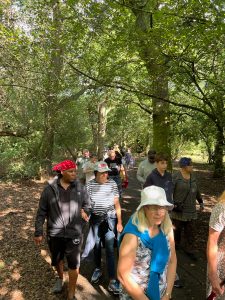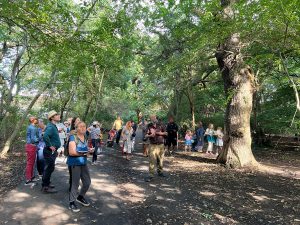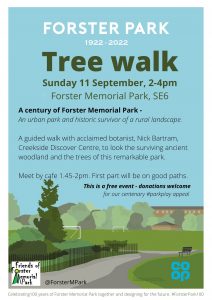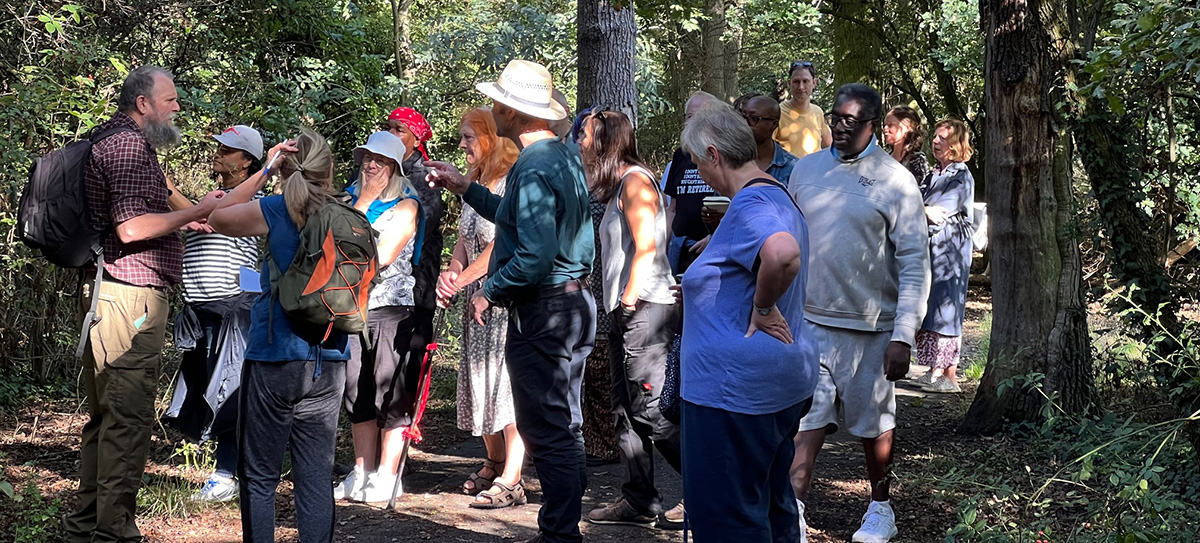On Sunday Sept 11th, Nick Bertram, from Creekside Discovery Centre in Deptford, led a Tree Walk round the park, telling us lots and lots of things we had no idea of. Starting from the cafe, a group of about 25 of us, headed towards the woodland path nearest the main Whitefoot entrance, where we very slowly made our way towards the Longhill entrance. On the way, Nick told us that:
The playing field is an assert, which was a clearing in the ancient woodland, and is easily seen on very old maps of the area. Forster Park, like Beckenham Place Park and The Woodland walk in Downham, is an area of Ancient Woodland. The official definition of this is woods before 1600, but there are ancient woodlands which are primeval and go back to the last Ice Age. Wildflowers such as native bluebells (another name for which is wild jacinth), anemones and wood mellick, are ancient woodland (or ancient hedgerow) indicators, especially if found together.
We then looked at trees along the path:
Hornbeam- Carpinus Betulus – can be an ancient woodland indicator. Has a silvery snakeskin diamond patterned bark. The leaf is tooth edged, then each tooth serrated, so the leaf is doubly serrated. The wood is slow growing and extremely hard. In the past, each species of wood had its own use, wood was used for everything, – keeping warm, furniture etc. Woods survived because they were coppiced- cut low down to produce many stems, producing a regular supply of wood. Deciduous trees were coppiced, in rotation, depending on the species, maybe a 5 year to 25/30 year cycle. Coppicing stopped some years ago and woods aren’t managed in the right way now.
Field maple- Acer Campestre- a truly native maple. The other maples which can be found are sycamore (originally from Mediterranean) and Norway maple.
Oak- 2 native species – peduncular and sessile, which do hybridise. And 3 Mediterranean species – Turkey oak, cork oak and Holm oak (evergreen), which have gone wild.
The Peduncular is also called the English oak, Quercus Robur, and is the dominant one in London. It has a short stem to the leaf, with rounded lobes (ears?) at the base of the leaf. The Sessile oak, Quercus Petrea, likes more acid conditions, has no stalk, and no lobes, the base of the leaf just slants in.
Elm- we saw plenty of Wych Elm, this is native (unlike the so-called English Elm which was brought over by the Romans!). Wych elm leaves are very big, about 5 inch, pointed, serrated, lop sided at the base. Whereas English elm leaf is about a quarter of the size.
Rough hairy feel to the leaves. Dutch Elm disease (so called because a Dutch scientist worked out what it was) – we lost nearly all the mature Elm trees in UK in 70s and early 80s to this disease – they were tall distinctive trees, a great loss to the landscape. The fungus was a different species to before, arrived cos of world trade (we were then still moving tree trunks around the world with the bark still on). The fungus was carried on the back of a female beetle which bore holes in the bark to deposit eggs. The tree would react to the presence of the fungus by shutting down its up and down transport system – xylem and phloem. The disease hasn’t gone away. Wych Elm reproduces by seed and can only grow to a certain height. The English Elm does not die back, it spreads by roots, and new trees spring up from them, but not tall.
As we walked down the first path, on the left, set back a bit, we saw many coppiced Wych Elm, perhaps 4-500 years old, and maybe the oldest trees of all species in the park. Some trees are much older or younger than they look.
Ash – this is one the two most common native species in London. There are several Ash trees in the park – most seem to be ok, this one was recently felled due to ash dieback. It has pinnate leaves – several leaflets arranged opposite each other on a stem, making one leaf.
Hazel- fairly low growing, leaves are alternate, broad and roundish, with doubly toothed edges, ending in a short tip. Leaves feel soft.
He pointed out that there wasn’t much of a shrub layer, as it used to be cut back by park management, though not now. Where there was a break in the canopy we saw some young wild trees – hawthorn, wild cherry, ash, and wild rose. But cutting that shrub layer has meant loss of native bluebells, anemones etc. Woodlands need to be managed for biodiversity. Oak don’t regenerate much within woodlands- there’s a mildew affecting them- though they can grow at the edge of woodland or outside it. He recommended Oliver Rackham as an intellectual author who really knows species, for a broad understanding of issues.
Just before the end of the first path, before the bin, on the left we came across stinking iris which grows wild in woods, then a snowberry shrub, with very round leaves- this is a North American shrub which has been planted.
We turned the first corner (!). away from the Longhill entrance and saw an old Oak just on the left, where half the trunk all the way up, was different to the other usual half. Could be the effect of lightening a while back but seems like healthy growth higher up. Old oak trees hollow out, and this actually keeps them stronger, so they live longer. There is a huge range of age of trees in the woodland- unlike a plantation- and this is all part of what to understand about the woodland.
Elder- we saw several, and they were all very affected by the drought. Many dead leaves and dead thin branches. Looks like the rain came just in time, because there is new growth. Elder has pinnate leaves, leaflets arranged in opposite way around the stem, like ash but fewer leaflets – commonly about 5 leaflets. Elder trees fruits early, which is great for birds.
Holly- this has a negative effect on woodland, tends to take over, like ivy does. Holly used to be broken down and used for animal winter fodder, and therefore was cut back and managed. Ivy can be a nuisance, especially when it trails the woodland floor, preventing other species. Ivy flowers, berries however are good for wildlife, as food and as a habitat. Should be managed though.
Hawthorn- saw two types- the usual Crataegus Monogyna, and the Woodland, (or Midland) Hawthorn. The latter is an ancient woodland/ hedgerow indicator. You can tell by picking a haw (the ‘berry’) and finding 2 stones inside it. Monogyna only has one. The woodland hawthorn was halfway down this section on the right.
We got to the end and crossed over, down toward a field. Nick showed us his maps again. This time an aerial photo from 1947, clearly showing that all the fields and meadow areas were used as allotments then. At the bottom of the fields are Lombardy Poplars, in a straight line – and clearly were planted, as were the Scots pines down the side of Conisbrough College. Looking at the field, what is missing? Wildflowers. Nick said it was in a very poor state. Wildflower meadows are hard to create, but it can be done by collecting local wildflower seeds, and possibly wildflowers from destroyed sites.
About planting acorns- can collect acorns, grow on at home and plant near Oak trees, and fence off, but we need to really really understand what is already there, and what the long-term affect would be, and what management would be required. Don’t rush into planting. Rapid mass tree planting has ruined many landscapes with rare wildflowers all over UK and other countries, and as happened only in Greenwich.
Turning left along the woodland edge, we came across an Oak with leathery leaves, probably a hybrid, possibly with Holm Aak, or looking at the bark, could be with cork oak. Turning left into the woodland at this point, we walked up back towards the corner of playing field closest to the lower Whitefoot entrance. There we came across several wild service trees.
Wild service tree – an ancient woodland indicator, also found in BPP, and in large numbers in Oxleas Woods. Distinctive leaf shape, with several sharp points, very symmetrical. Also called the Chequer tree.
We went back on ourselves in search of the oldest Oak trees These have been pollarded, and some are about 350-400 years old. Pollarding is being cut back high up so animals can still graze and not eat the tree. England has one of the highest concentrations of pollarded trees, and BPP and Mayow Park also have many. Pollarding stopped over 100 years ago. Pollarded trees are often on the edge of woods or planted along footpaths as parish or other boundaries. Many of our ones are along the top edge of the dog walking enclosure.
There we finished, and didn’t have time to see the Whitebeam, a native tree though here it was planted, as it prefers chalk soil, and our one is along the west side of the playing field. Nor to see the Silver Birch, Blackthorn, and others.
As a conservationist, Nick emphasised the importance of understanding and preserving the whole ecology of the woodland, the problems of introduced species, poor management and climate change, which is increasing the number of evergreens in woodland. We learned so much, and hope to see Nick again, in a different season, as there is so much more we can learn about our park.










Thanks for this report, it was a shame I missed the walk, but this is really informative! Hopefully I will be able to join the next one.